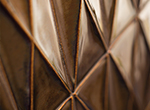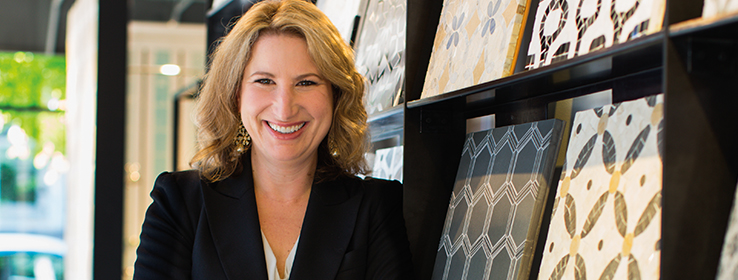By Charlotte Stoudt
From fruit-embedded tile to porcelain "wood", tile design guru DeeDee Gundberg expands the possibilities of an ancient art form.
STIR: How did you first become interested in design?
DG: I've always loved seeing the inside of people's homes. I was reading Architectural Digest when I was 8.

STIR: Your new Market collection of tiles features tissue-thin slices of real fruits and vegetables preserved between layers of glass. What's the back story?
DG: When artist Tony Davlin approached me with the idea, I was really excited. My job was to make sure we balanced the right blend of color and texture. We also didn't want to overwhelm the customer with too many options. Certain fruits are not in season all year long. Some are too exotic and expensive. Starfruit is cool-looking but not always available. I was excited about the idea of a radish, but it didn't pan out. The pear is incredible. The way the colors blend together, the tiles look dusted in gold.
STIR: What's the most surprising trend in tile design today?
DG: Porcelain flooring. It was always considered cheap, a secondary option for a laundry room or guest bath. For a long time it was hard to find really beautiful porcelain. Now with inkjet technology, you can print a very high resolution directly onto the surface of the tile. The technology took off around 2000 and has improved substantially year after year, with better resolution and more realistic imagery, to the point where it's difficult to tell the difference between a porcelain tile made to look like marble — or wood or concrete or granite — and the real thing. Sometimes I cannot tell the difference until I touch it, as a marble tile will always be cool to the touch. If I'm fooled, then I know we need to launch it!
STIR: How has technology expanded your color and design options?
DG: Older methods of printing images on porcelain often left the image pixelated and the color dull. Inkjet technology can print up to 1,000 dpi, so no pixelation will occur, and color remains rich and layered.
STIR: What other technological advances have influenced how you design tile?
DG: Waterjet technology has revolutionized how we make mosaics. And a CNC [Computer Numerical Control] machine can carve marble into gorgeous dimensional shapes. Dimensional tile like Network, which mimics wood paneling, is a fantastic way to bring visual interest to a feature wall without being over the top. People really respond to it. It's very Mad Men.





